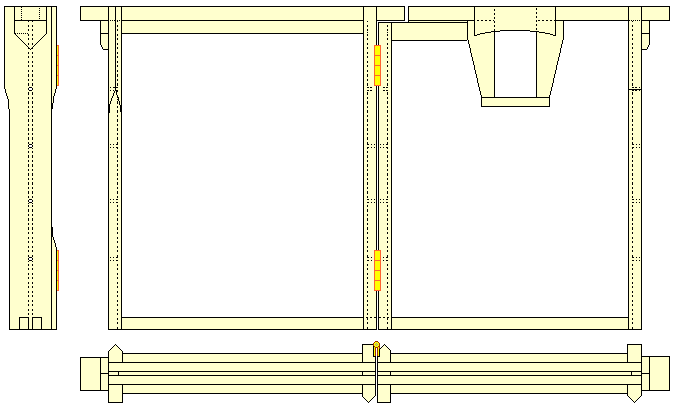Special or Unusual Frames
Mating Hives
Triplefold Frame
|
|
|
|---|
|
Special or Unusual Frames Mating Hives Triplefold Frame |
Bifold Frames, for UK Bee Hives |
|---|
 The Triplefold frames were a good idea
in some respects, but there were drawbacks. As there was only space in the nuc
for the three folded panels, there was no provision for feeding. As we are
dealing with small colonies of bees that have been selected or filtered to have
a greater proportion of young nurse bees, as can be achieved using the
Marburg Swarm Box,
it was thought that there may not be enough bees foraging or that if there were
they could be better employed "at home" saving their flying energy. I
also think that by providing food the lower amount of forager flying will result
in less drifting between nucs.
The Triplefold frames were a good idea
in some respects, but there were drawbacks. As there was only space in the nuc
for the three folded panels, there was no provision for feeding. As we are
dealing with small colonies of bees that have been selected or filtered to have
a greater proportion of young nurse bees, as can be achieved using the
Marburg Swarm Box,
it was thought that there may not be enough bees foraging or that if there were
they could be better employed "at home" saving their flying energy. I
also think that by providing food the lower amount of forager flying will result
in less drifting between nucs.
There was no provision for comb drawing within the nuc. The brood cell count was inadequate for testing the freshly mated queens. My first solution was to make some mating nucs that would take a Triplefold frame, a 1/3rd width frame and a 1/3rd width frame feeder. It then occurred to me that five 1/3rd width frames have a total width that was the same as a half width frame (I also had many of these already in use). It was a simple step to produce a design that would accept 5 x 1/3rd width frames along the box or 3 x 1/2 width frames across the box. A frame that was hinged only in the centre was much simpler to make and stronger (because there were fewer joints to fail or move) and could still be used in a full sized box over winter. The wooden parts that bear the hinges are shaped as in the drawing at left. |
The drawing below shows a
Cell Space incorporated into one half of the frame,
this is optional and I have some "with" and some
"without" this feature.

|
Dave Cushman.
Page created Summer 2000
Page updated 06/12/2022
Originated... Summer 2000, Revised... 11 October 2001, Coding Corrections & update... 10 October 2002, New Domain... 23 July 2004, |
|
|
|---|